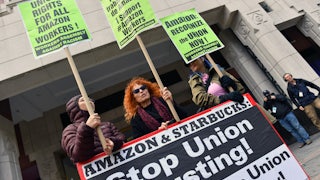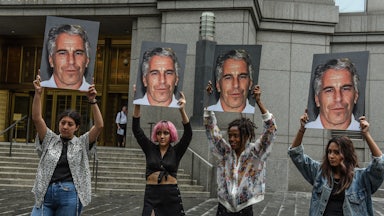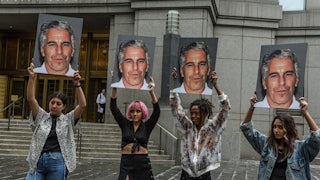Since the heyday of Jane Austen, new truths have emerged that are universally acknowledged: Anyone younger than 40, without family money, is unable to afford a nice house. Alexa and Siri, no matter how politely you ask them, never clear the table or do the dishes. And, of course, the Democrats are facing a wipeout in November that will force everyone to rush to the dictionary to search for a weather term stronger than tsunami.
Democratic gloom is omnipresent. Conversations with party insiders—from pollsters to strategists—make the fans of hapless baseball teams like the Baltimore Orioles seem like wild-eyed optimists. No one wants to concede on the record that it is lower-the-lifeboats time for the Democrats, but that is the prevailing message once a reporter closes their notebook.
Political reporters seize on all the dire indicators for November, especially President Biden’s approval ratings, mired in low-40s quicksand. Politico’s Playbook reported last week on two focus groups with Black and younger voters that supposedly embody the “brutal midterm environment.” A key factor for both groups: “Deep frustration that President Joe Biden and Democrats have failed to deliver on their early promises.”
Even dubious network hiring decisions are premised on a GOP takeover. A CBS executive—justifying the credibility-sapping hiring of Mick Mulvaney (Donald Trump’s former chief of staff) as a paid commentator—recently explained his rationale in an internal meeting: “We know the Republicans are going to take over, most likely, in the midterms.”
In contrast to this widespread premature certainty about November, interviews with political scientists create a more nuanced portrait. It isn’t that anyone in academia is in denial about Biden’s popularity or other short-term political indicators. But they are skeptical that matters are already set at this early date. “In my mind, it’s still volatile,” said Robert Erikson, a political science professor at Columbia University. “You can still have a situation where you could have a Democratic triumph, or they could end up with their tail between their legs. I just don’t know what will happen with voters who aren’t currently paying attention.”
Most journalistic forecasts about 2022 treat as an unalterable rule of physics the historical pattern that the president’s party loses House and (usually) Senate seats in off-year elections. (Since the darkest days of the Depression in 1934, the only exceptions on the House side have been 1998 and 2002.) That expectation, of course, presumes that 2022 is a normal political year and nothing will change between now and November.
Dynamic inaction captures the current mood on Capitol Hill—and the safe bet is that this paralysis will continue until November. Almost certainly, the confirmation of Ketanji Brown Jackson to the Supreme Court pretty much exhausts what Biden and the Democrats can expect from an evenly divided Congress. But scenarios of a Democratic rebound do not require Joe Manchin suddenly to decide—like Scrooge after seeing the ghosts of Christmas—that he wants to spend trillions on social programs and battling climate change out of a newfound spirit of generosity.
Political scientist Julia Azari, who teaches at Marquette University, succinctly captured the political weirdness of 2022 when she said, “This is our first midterm after a pandemic and an insurrection.”
Many in politics treat the virus as yesterday’s news, even after the annual Gridiron Dinner in Washington appears to have been a superspreader event. Congress scampered out of town for its two-week Easter break without bothering to pass a stripped-down $10 billion pandemic package. A late-March Gallup poll found that only 3 percent of Americans consider Covid-19 to be the most important issue facing the country.
Despite these survey results (which echo a mid-March NBC News poll), it defies reason to believe that a pandemic that lowered American life expectancy two years running will not have lasting political consequences. The lingering effects of the virus color almost every poll question about the state of the nation, even when Covid isn’t mentioned, as I have argued previously. “Covid casts a shadow,” said John Sides, a political scientist at Vanderbilt University. “Finding a one-to-one relationship between the pandemic and Biden’s approval ratings is difficult. But there are ripple effects.”
Another variable, to which Azari alluded, is the set of public hearings the House committee on the January 6 insurrection will hold later this spring. Forecasting the lasting results of televised hearings that haven’t yet occurred is a mug’s game.
It is certainly plausible that the parade of public witnesses will do little more than give Democrats and Never Trump Republicans new reasons to loathe the forty-fifth president.
But the hearings can also point up what Rachel Bitecofer, a Ph.D. polling analyst and Democratic political strategist, considers the dominant strategy for 2022 and beyond: demonizing the Republican brand. “The only strategy that works,” she said, “is to make change a scary concept for the electorate. It has to be democracy versus autocracy.”
That dramatic contrast, which Bitecofer believes should be the central theme of the Democratic message this year, does not argue for a politics-as-usual environment. Nevertheless, the latest TV ad from the House Majority PAC, an outside group closely connected to Nancy Pelosi, suggests that Democrats will make a more prosaic, economic argument. Racing from 7.9 million new jobs to a House vote putting a cap on the cost of insulin, the TV spot boasts, “Democrats are getting things done.”
The logic behind this ad is obvious: trying to move the economic conversation away from inflation. Normally, political scientists stress economic growth in advance of an election as a key leading indicator. But inflation has changed the short-term political equation. “The reason that inflation—particularly gas prices—has more salience is that it is more visible than the unemployment rate on a daily basis,” Sides said. “Also in news coverage, bad news always dominates good news.”
Any political seer who can accurately forecast gas prices when Americans vote in the fall should be on Wall Street rather than predicting elections. Often in politics the direction of the economy matters more than the aggregate numbers. Ronald Reagan carried 49 states in 1984 with his “Morning in America” theme, even though inflation was still at 4 percent and unemployment over 7 percent. What mattered, though, is that both numbers, under Reagan, had sharply declined from earlier heights.
Extrapolations from prior elections also ignore what Azari called “the new hyperpartisanship” that has virtually ended the era of ticket splitting. No Democrat, the Marquette professor said using a convenient Wisconsin example, will vote for conservative Ron Johnson to somehow counterbalance Joe Biden.
The underappreciated truth is that this is an off-year election without historical parallels. A Supreme Court decision eviscerating or overturning Roe v. Wade could galvanize Democratic turnout. In the midst of the global crisis in Ukraine—with Americans again worrying about the specter of nuclear war—it is impossible to predict the role that Biden’s foreign policy leadership might play in November.
When an off-year election can encompass everything from a once-in-a-century pandemic to the most devastating war in Europe in three-quarters of a century, it impossible to gauge November by the mood in April. What, in fact, we are slouching toward is a Bette Davis election. As she dramatically announced in All About Eve, “Fasten your seatbelts. It’s going to be a bumpy night.”








